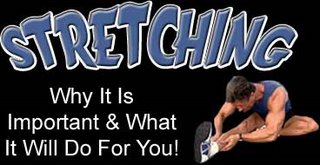 Stretching is a fundamental way to improve your overall health and fitness. By incorporating a regular flexibility program into your exercise routine you will:
Stretching is a fundamental way to improve your overall health and fitness. By incorporating a regular flexibility program into your exercise routine you will:- decrease pain and soreness after exercise
- improve circulation
- improve posture
- decrease muscle tension
- reduce muscle soreness
- allow time for mental training, such as visualization
- lengthen muscles and increase range of motion, which helps lengthen your stride
- help prevent muscle and joint injuries by elongating and relaxing muscles
- flush lactic acid out of your muscles.
 A complete stretching routine can take as little as 10 minutes. The best time to stretch is after you have warmed up and the muscles are warm. The best time to perform your flexibility routine is after exercise. This is when the muscle is the warmest and when you can use the relaxation. Focus on stretching the muscles you use the most during your specific exercise or sport.
A complete stretching routine can take as little as 10 minutes. The best time to stretch is after you have warmed up and the muscles are warm. The best time to perform your flexibility routine is after exercise. This is when the muscle is the warmest and when you can use the relaxation. Focus on stretching the muscles you use the most during your specific exercise or sport.
Proper Stretching Technique
- Perform balanced stretching. This means you should always stretch the muscles on both sides of your body evenly. Don’t stretch one side more than the other side.
- Avoid over-stretching. Never stretch to the point of pain or discomfort. You will feel slight tension or a pull on the muscle at the peak of the stretch.
- Go slow! Always stretch slowly and evenly. Hold the stretch for about fifteen seconds and release slowly as well.
- Never bounce or jerk while stretching. This can cause injury as a muscle is pushed beyond it’s ability. All stretches should be smooth, and slow.
- Don’t forget to breathe. Flexibility exercises should be relaxing. Deep easy, even breathing is key to relaxation. Never hold your breath while you stretch.

Stretching Do's and Do Nots
Do...
- warm up thoroughly first
- ease into a stretching routine
- only static stretches (slow, rhythmic movement)
- pay attention to your breathing (take deep belly breaths)
- make stretching a habit
- relax
- listen to your body
Do Not...
- hold your breath
- bounce
- force a stretch
- hold painful stretches
- stretch injured muscles
- hurry through your routine
 Use Static Stretching
Use Static Stretching
Static stretching involves a slow, gradual and controlled elongation of the muscle though the full range of motion and held for 15-30 seconds in the furthest comfortable position (without pain). This is the first and most important stretching principle. In our opinion, all stretches for each muscle group should be done by using this static form of stretching.
How often you should stretch is still not fully understood. Most professionals would agree however, that daily stretching is best, during and after exercise sessions. Frequent stretching will help you avoid muscular imbalances, knots, tightness, and muscle soreness created by daily activities and exercise
 Always Warm-Up Before Stretching
Always Warm-Up Before Stretching
A warm muscle is much more easily stretched than a cold muscle. Never stretch a cold muscle, always warm-up first to get blood circulating throughout the body and into the muscles. A warm-up should be a slow, rhythmic exercise of larger muscle groups done before an activity. Riding a bicycle or walking works well.
This provides the body with a period of adjustment between rest and the activity. The warm-up should last about 5-10 minutes and should be similar to the activity that you are about to do, but at a much lower intensity. Once you have warmed up at a low intensity for about 5-10 minutes and have gotten your muscles warm, you can now stretch. Stretch Before and After Exercise
Stretch Before and After Exercise
I recommend stretching both before and after exercise, each for different reasons. Stretching before an activity (after the warm-up) improves dynamic flexibility and reduces the chance of injury. Stretching after exercise ensures muscle relaxation, facilitating normal resting length, circulation to joint and tissue structures, and removal of unwanted waste products, thus reducing muscle soreness and stiffness. Body temperature is highest right after the cardiovascular exercise program and/or after strength training.
In order to achieve maximum results in range of motion and to receive other benefits, it is highly recommended that you do static stretching at this point in your workout, just after your cardiovascular program and during or after your strength-training program.
It is your body, take good care of it... if not, Burma will.....(see pic above)
More readings:
http://en.wikipedia.org/wiki/Stretching
http://en.wikipedia.org/wiki/Warming_up
No comments:
Post a Comment